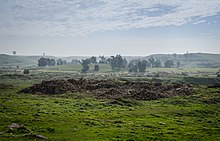Dair Mar Elia
Dair Mar Elia ( Aramaic ܕܝܪܐ ܕܡܪܝ ܐܝܠܝܐ, Arabic دير مار إيليا, DMG Dair Mār Īliyā ), known as Saint Elias Monastery , was a 6th century Christian monastery that was probably destroyed by Islamists in 2014 . It was the oldest of its kind in Iraq and was located in the Nineveh Governorate just south of Mosul .
The monastery was founded around 595 by Mar Elia, an Aramaic monk who studied first in al-Hira and then in the large monastery on Mount Ezla near Nusaybin in what is now Turkey . The monastery was later claimed by the Chaldeans . It was the center of the regional Christian community and over the centuries thousands of Christians have visited the monastery to celebrate the holiday of Mar Elijah, which falls on the last Wednesday of November.
The monastery was renovated in the 17th century under Hurmizd Alquschnaya. In 1743, the Persian leader Tahmaz Nader Shah ordered the destruction of the monastery and the murder of the 150 monks living there. The monastery was in ruins until the beginning of the 20th century when some restorations were completed on a few halls and rooms. During the First World War and the genocide of the Syrians in the Ottoman Empire was Dair Mar Elia a shelter, which led a part of the facility for reconstruction.
After the 2003 Iraq War , the site was located within Forward Operating Base Marez, and US units began to visit the site. After being evacuated by the retreating Iraqi Republican Guard , the 101st Airborne Division assumed responsibility for the area. The 94th Engineer Battalion later carried out a topographical survey of the monastery. Dair Mar Elia has been fenced in to protect the site as well as military chaplains on their tours of the ruins. These actions were part of a long-running effort to help local Iraqis become more aware of the site and raise awareness about the preservation of monuments .
In May 2008, Iraqi archaeologists were able to visit the areas for the first time since the Second Gulf War . While some places needed protection from the weather, large parts were unexcavated and thus protected from grave robbers.
On January 20, 2016, English-language media reported that the terrorist organization Islamic State had destroyed the monastery in autumn 2014.
Individual evidence
- ^ A b Smithsonian Magazine, Sep 16, 2008
- ↑ a b Isis has destroyed Iraq's oldest Christian monastery, satellite images confirm. In: The Guardian . Associated Press , January 20, 2016, accessed January 20, 2016 .
- ^ NPR's Morning Edition, November 21, 2007
- ↑ a b c Sad certainty: Oldest monastery in Iraq destroyed
- ↑ Long Knife Soldiers Take A Journey Back in Time ( Memento from February 19, 2012 in the Internet Archive )
- ↑ Chronicle of Seert 13: 445.
- ↑ Christians of Iraq ( Memento from December 2, 2013 in the Internet Archive )
- ↑ Sgt. Mitch Armbruster, 207th MPAD Journalist: Soldiers Visit Ancient Monastery . In: News Blaze . December 23, 2005.
- ↑ STEVEN LEE MYERS: GI's in Iraq Hope to Heal Sacred Walls . In: NYT . December 18, 2009.
- ↑ http://www.nytimes.com/slideshow/2009/12/19/world/1219-MONASTERY_2.html
- ↑ Martha Mendoza, Maya Alleruzzo, Bram Janssen: Only On AP: The oldest Christian monastery in Iraq has been reduced to a field of rubble, yet another victim of the Islamic State's relentless destruction of ancient cultural sites. In: US News & World Report . Associated Press , January 20, 2016, accessed January 20, 2016 .
Web links
- New York Times photo gallery of restoration efforts at Dair Mar Elia
- Article on restoration efforts from Smithsonian magazine
Coordinates: 36 ° 17 ′ 32.6 ″ N , 43 ° 7 ′ 51.6 ″ E



